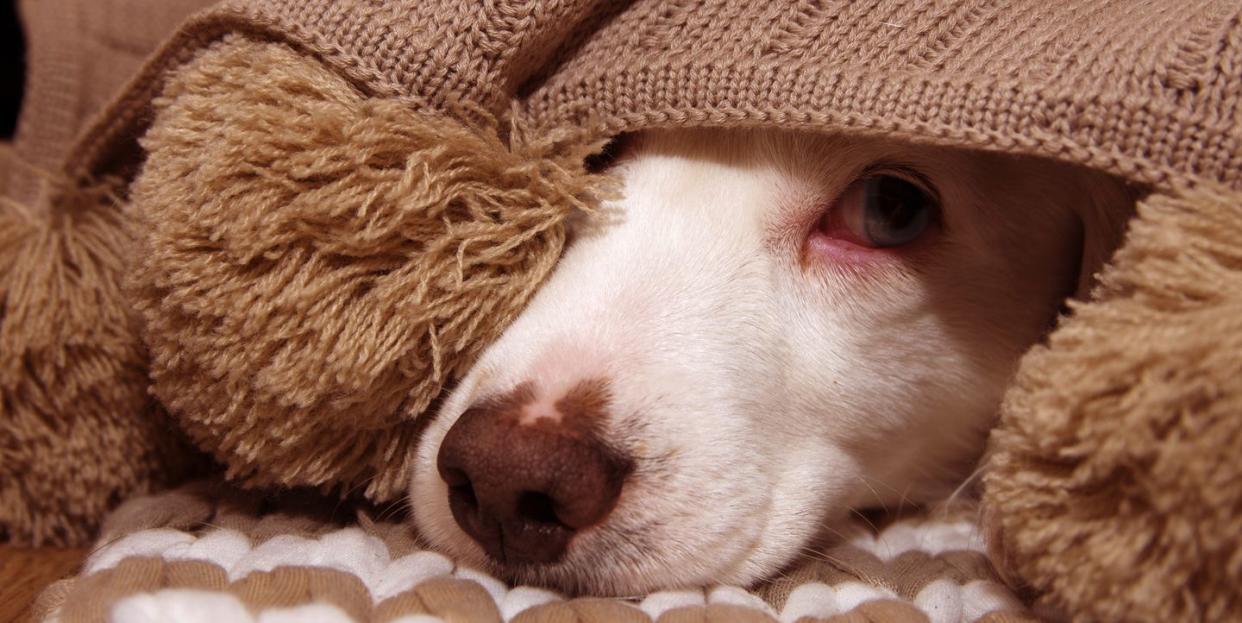Keep Your Dog From Getting Spooked This 4th of July With Some Firework Safety Tips

Though the 4th of July is traditionally a day full of fun American celebration, it's not usually a fun day for dogs. In fact, the Humane Society of America has said that historically July 5 is the organization's busiest day, as its shelters fill up with animals who have run away from home the previous night and are scared and disoriented. 4th of July festivities such as backyard BBQs and fireworks shows can quickly become disastrous for dogs. The shows can be "traumatizing for dogs," Carl Peterson, CEO of Bark Busters, an at-home dog training service, tells Woman's Day. "Dogs' fight-or-flight instinct may be raised by loud sounds and bright lights during even small-scale celebrations." Peterson says that a dog's hearing is four times as sensitive as a human's, which means those booms that are loud for us are even more explosive for you pup.
How to tell if your dog is upset
Just like humans, fear in animals manifests in different way depending on the individual. But there are some useful clues you can look for to indicate how your dog is doing.
"A dog's body language can tell you a lot about what they're feeling," Peterson says. If your usually calm dog is pacing, panting, or clinging to you it could be a sign of anxiety. There are also physical cues such as hair standing up, tail tucked between legs, and avoiding eye contact that Peterson says can be indications of fear. He says in extreme cases aggression, biting, barking uncontrollably, destructiveness, and submissive urination are also signs that your dog is highly upset or afraid.
How to calm your dog's fears and anxiety
There are a lot of simple things you can do that will make a significant difference to your dog. Options include bringing them inside away from the noise, providing a special den-like area like a crate or kennel, closing windows and curtains to reduce noise and bright flashes, and turning on a TV, radio, or relaxing music at normal volume to distract from any outside noise.
If your dog is still anxious, Peterson recommends making your dog think. "Dogs can’t think about two things at once," he says. "So engaging your dog's brain is a great way to calm them down." He recommends creating an obstacle course in your house and walking your dog through it on a fixed-length leash. "The continued movement will help dispel his adrenaline," he says. Another fun option could be one of these brain games for dogs.
What to do if you're setting off sparklers at home
As with humans, the main thing to keep in mind when dealing with any kind of explosives at home is to be safe. Don't allow your pets anywhere near any dangerous materials. "Be sure to remember that it’s not just fireworks that are hazardous to dogs," Peterson says. "Certain matches contain chlorates which can result in difficulty breathing if ingested. Also, lighter fluid can irritate your dog's skin and cause depression if swallowed."
The best thing you can do if you plan on setting off explosives outside is to keep the dog in the house so there's no way they can get near it. Preferably, make sure someone is inside with the dog to make sure it's calm, entertained, and distracted, as the loud nearby noises could cause panic, especially if the pet is alone.
And potential 4th of July toxicity goes beyond sparklers. Sunscreen and insect repellent should not be put on pets. DEET, a common insecticide, can cause vomiting or diarrhea in pets, Peterson says. And if you're planning on popping open a cold one or enjoying a cocktail, make sure they're kept out of reach, too, as alcohol can poison pets and in extreme cases lead to comas or respiratory failure.
What else you should know this 4th of July
When in doubt, know that your dog is looking up to you. "Dogs look to pack leaders for guidance in tense situations," Peterson says. "By cementing your leadership role and status as a trusted, respected figure, you can help reassure your dog of its safety." He advises that you model calm behavior by speaking matter-of-factly instead of in a sympathetic voice and act as you normally would to your dog.
And of course, prepare for the worst just in case. It's important to be prepared in the event that your dog panics and is able to escape your home. The Humane Society recommends checking that your dog's ID tags are properly attached to your pet’s collar and that they have your current contact information, including your cell number.
Want more Woman’s Day? Subscribe to Woman's Day today and get 73% off your first 12 issues. And while you’re at it, sign up for our FREE newsletter for even more of the Woman's Day content you want.
You Might Also Like


